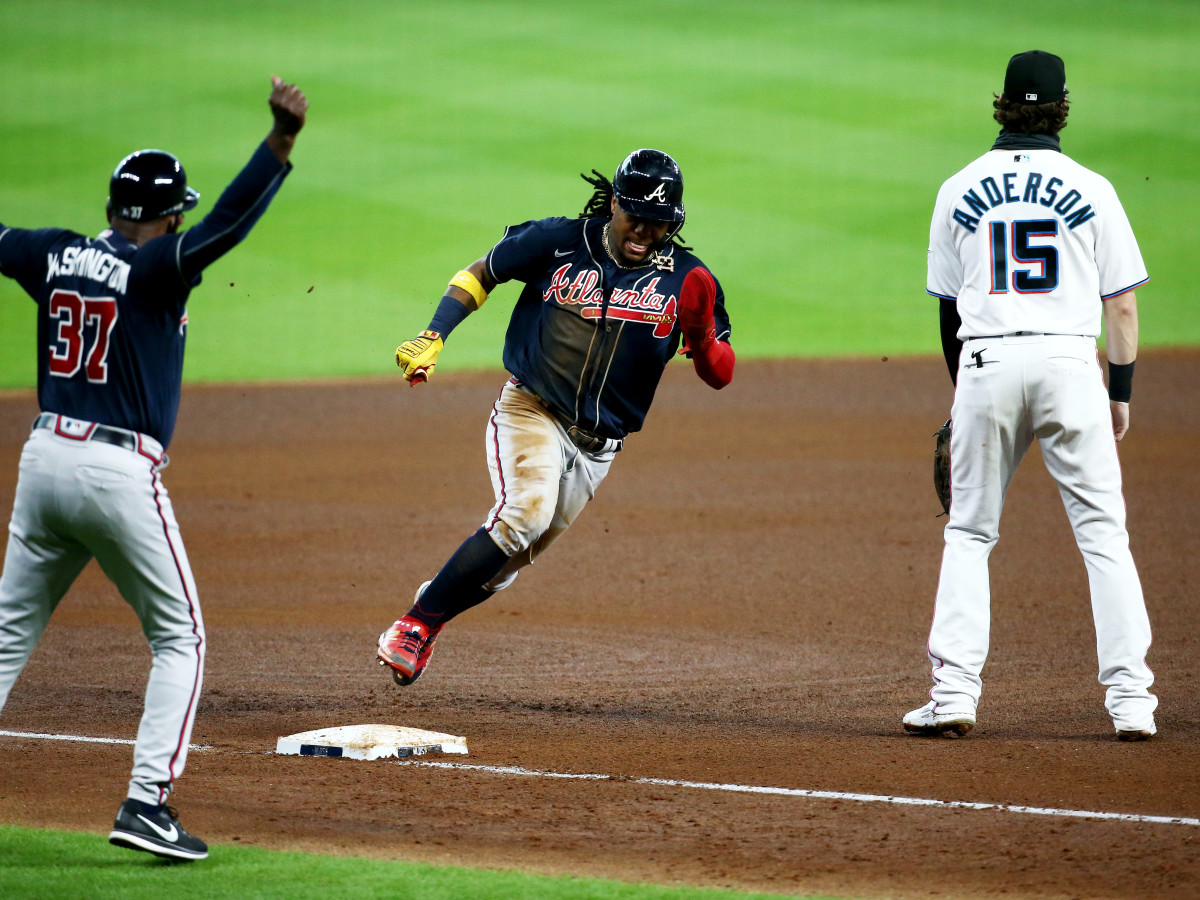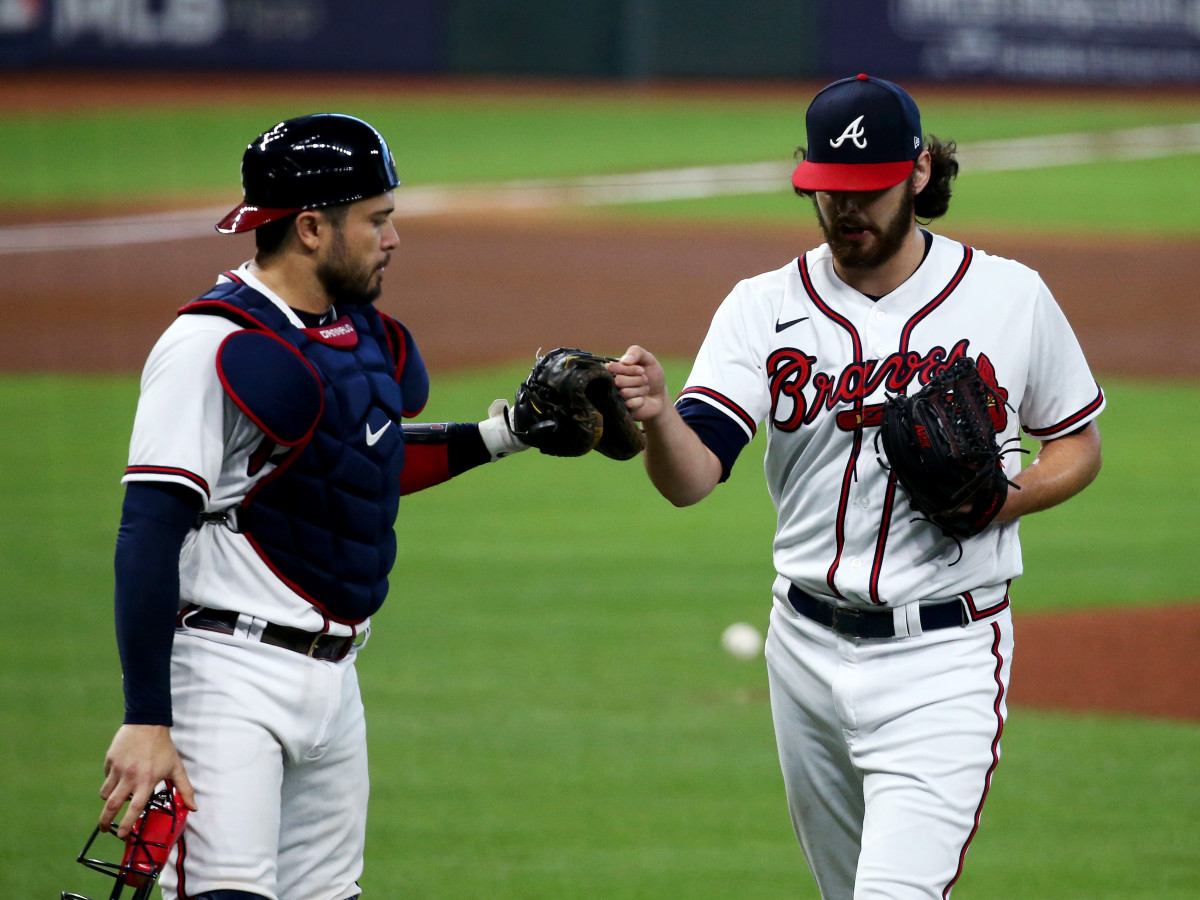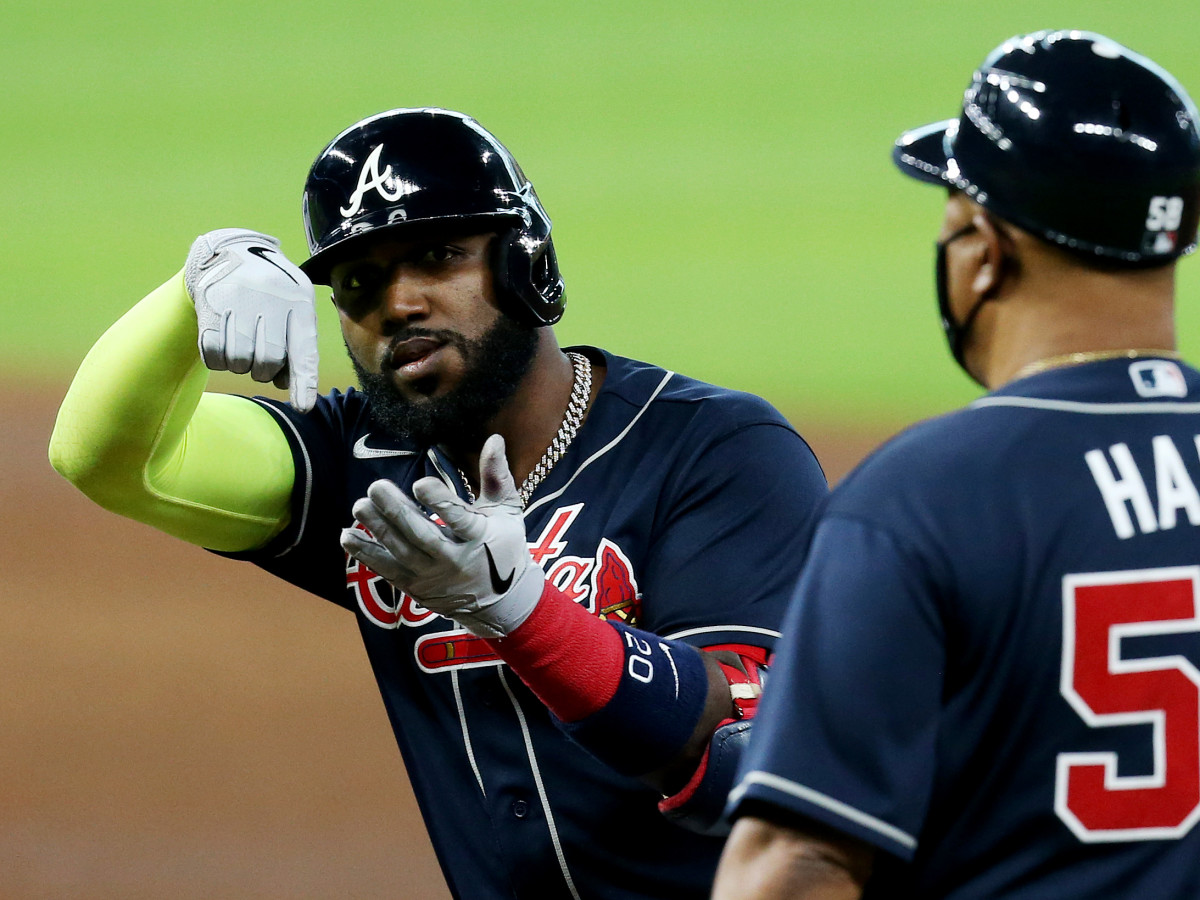Braves Playing Most Complete Postseason Baseball in Decades
HOUSTON – The readings resembled the recording of daily temperature checks required of them in the postseason bubble: 96, 97, 98, 96, 97, 97, 95, 95. Such were the velocities of pitches the Braves hammered Thursday from Marlins pitchers for hits or, in one case, a sacrifice fly. All but three of the Braves’ 10 hits and all but one of their runs in a 7–0 win that clinched a National League Division Series sweep resulted from fastballs at 95 or faster.
The Marlins were fiercely proud of their young pitchers’ velocity. They had the highest average pitch velocity of any team in the postseason (92.8). Marlins manager Don Mattingly wanted his pitchers to attack Atlanta with fastballs. They did, and now they are home because the fastball-feasting Braves hit .357 against Miami’s fastballs.
If you were an advance scout from the Dodgers or Padres, you needed the James Webb Space Telescope to find a flaw to exploit with the Braves. They are off to one of the most complete runs in postseason history since the baseballs were dead and the mounds were high.
In five postseason games, Atlanta is 5–0, has outscored its opponents 24–5 and out-homered them 7–1.
The Braves are the best fastball-hitting team since the 2015 world champion Royals (.312) and the best slugging team against fastballs in the 13 seasons of such recorded history (.551). By now it should be obvious: The stove is hot; don’t touch it to see if it is.

It turns out that the best way to beat the rip-roaring Braves is to pitch like … the Braves. Atlanta pitchers closed the NLDS with 19 scoreless innings.
“This series here,” said Braves manager Brian Snitker, “what those guys did on the mound was almost mind-blowing.”
The secret sauce to Atlanta turning into the 1905 Giants with Mathewson and McGinnity or the 1966 Orioles with Palmer and McNally is what is going on in their dugout after every half inning. It is a cabal of catchers. Braves catcher Travis d’Arnaud will huddle with backup catcher Tyler Flowers and catching coach Sal Fasano to review the next group of hitters due to meet their demise at the hands of the Atlanta pitchers.
The cabal begins with a heavily detailed pregame run prevention script cobbled together by director of operations Alex Tamin and his analysts. Tamin, who earned a law degree from UCLA in 1995, was poached from the quant-loving Dodgers before the 2018 season by GM Alex Anthopolous, a Dodgers alum himself. Tamin took many of the systems the Dodgers used, including defensive positioning charts for position players that are specific to the pitcher on the mound at the time.
As Snitker joked to me before the series, “We have so many color-coded charts and diagrams I don’t know how we haven’t run out of ink. But in the heat of the moment back there, Travis does a great job. I always liked him. It just seemed he was hurt a lot. Now I’ve come to find out he’s a much, much better player than I ever knew.”
“We’ve got great game-planning going on every inning,” d’Arnaud said. “Tyler Flowers is next to me between every inning. He tells me what he sees. Sal’s been doing the same thing. It’s been a tremendous help to get those guys’ input, who’ve been two big league catchers for a long time.
“Those two guys, and even the guys behind the doors, Tamlin and five other guys who have been a tremendous help in coming up with a great game plan. And hats off to the pitchers who have done nothing but execute it, and just trusted their stuff and didn’t overthink.”
The pitchers don’t need to bother to sit in on these diabolical sessions. All they need to do is follow the signs that d’Arnaud puts down. And they do. Atlanta pitchers rarely shake him, mostly because they know how much brainpower already has been put into the selection.

The catching cabal and the inkjet set behind them know what they are doing, especially in the postseason, with more advance time to cook up recipes, and especially with the kind of options Atlanta pitchers give them. Braves pitchers are dominating the postseason not as much with pure stuff as they are with masterful sequencing.
As opposed to the hard-throwing Marlins, the Braves entered Game 3 with the lowest average pitch velocity of any of the remaining playoff teams (88.1). The curveball of Max Fried, the changeup of Ian Anderson and the curveball and slider of Kyle Wright are thrown with enough frequency to keep hitters off their fastballs. It’s exactly the kind of approach the Braves’ NLCS opponent will have to take against those fastball-feeding Atlanta hitters. Speed them up and slow them down.
Game 3 was over in the third inning, and as most things go with the Braves, it ended quickly. This is what happened to Marlins starter Sixto Sánchez after Ronald Acuña Jr. reached second with one out in a scoreless game: Freddie Freeman ripped a 96 mph fastball for a single; Marcell Ozuna shot a 98 mph fastball through the right side for one run; d’Arnaud smashed a 96 mph, head-high fastball for a two-run double; and, after Ozzie Albies popped up a changeup, Dansby Swanson brought in a fourth run with a sacrifice fly off a 97 mph fastball.
The Marlins had one chance to get back into the game, but the cabal, with some advisory help from pitching coach Rick Kranitz, squelched it. Miami had the bases loaded in the bottom of that inning with two outs with Jazz Chisholm due up. Grant Dayton was throwing in the bullpen. Wright was one pitch away from coming out of the game.
With no fans in the stands, Wright said he could hear the pop of the bullpen catcher’s mitt. He knew his time was running short. Kranitz told him to trust his stuff.
“He just did a good job of settling me down,” Wright said. “I think that was a little bit of a wake-up call to get going and attack hitters a little better.”
Wright executed two curveballs to Chisholm, the second of which resulted in a groundball to escape the inning.
“Great meeting by Kranny!” d’Arnaud joked.
Said Wright, “I was a little shaky early on, but give a lot of credit to Travis. He calmed me back down. Called a great game.”
It also was yet another master stroke of sequencing. The curveball typically is Wright’s fifth-best pitch. He flummoxed Miami with sprinklings of curves and sliders, especially when he was in a jam. The ground ball from Chisholm started a run of 10 straight batters retired by Wright.
The Marlins are a plucky bunch with a bright future. As their veteran closer, Brandon Kintzler, said, “The window is just opening for this team. We just saw with the Cubs how the window is kind of closing. It goes by fast.”
This is a postseason unlike any other, in part because the NLCS will be played in as many as seven consecutive days. The Braves have the bullpen depth to handle the load. But it’s also different because the use of video monitors during games is out. Video rooms are off limits because of social distancing protocols during the pandemic. Pitchers routinely sit in the dugout during their team’s at bat. It takes old-fashioned brainpower to make in-game adjustments on the field and in the dugout. This has played into the Braves’ strengths.

But let’s be honest: Now the cabal and the inkjet set really have their work cut out. The Braves just dispatched a Reds team that was the worst hitting team in baseball (.212) and ranked 28th in runs per game, and a Marlins team that ranked 21st in runs per game and 25th in home runs. The NLCS brings a much bigger challenge as far as run prevention strategies.
Said Snitker, “The guys in that room are pretty confident that we’re a pretty good club and have a chance to do something pretty special.”
See, it doesn’t matter who the Braves beat. What matters now is how the Braves won five straight postseason games. Nothing went wrong. They were clinically good. They played 49 innings and trailed only once, and that deficit lasted only four innings before they threw up a six-pack of runs. No team is more confident right now than the Braves, nor have as many reasons to be so.
